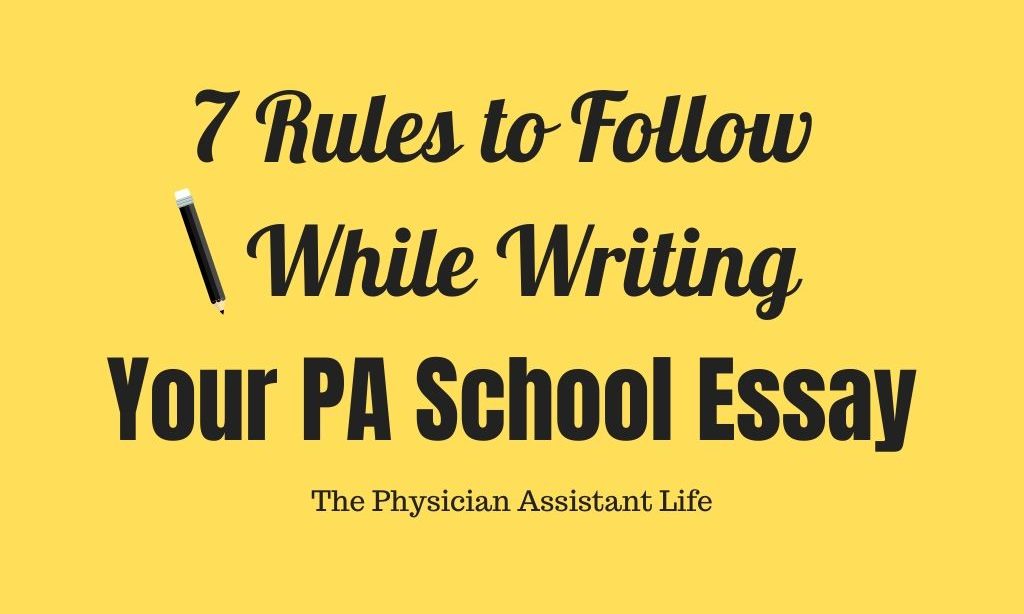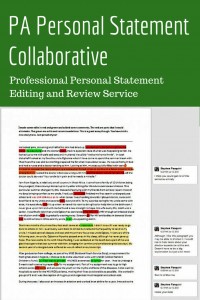You know you’re in a war, right?
PA school, once a bastion for rebels looking to buck the normal medical school model is now more competitive than ever.
The CASPA application is full of standard metrics like GPA, GRE scores, prerequisite requirements, and college transcripts which make it hard to differentiate yourself from the pack.
Where is the one place you can make your applications shine?
The PA School Essay!
Below are seven rules you should always follow when constructing the body of your PA school personal statement.
Review each rule carefully before and after you write your personal statement to win the war and make sure your essay stands out from the crowd.
Rule 1: Show – Don’t Tell
You’ll do this by creating images the readers will not forget.
Presenters at writers’ conferences repeatedly tell authors to show and not tell. The difficulty comes from thinking of showing and telling as two completely different ways of writing, when, in fact, showing and telling overlap like two interlocking rings.
You need to tell the reader your story. The difference is that in telling your story you create an image in the reader’s mind by using the five senses (showing). Think of telling as giving the reader a list of facts and generalizations. No image is created in their mind.
Think of the anecdote about the wheels used earlier. You can visualize the TA grabbing the essay, smiling at the student, and talking about the wheels. You can picture all those wheels scattered about in some random order. The story and the image convey his message about the importance of organization.
EXAMPLE 1: Telling Versus Showing.
Telling: The doctor closed the wound.
Showing: Blood covered the doctor’s surgical gloves as he stapled the two-inch wound in Tom’s thigh.
EXAMPLE 2: Show And Tell Using The Five Senses
That previous example is a simple one. Let’s look at a longer more complicated example.
Think back on the “show and tell” you did when you were in elementary school. Children would bring one of their favorite toys and tell the class about it. In this example, it’s a teddy bear. The teddy bear is the image the child holds up for the class to see. It’s concrete. How clear would the image be if the child left the teddy bear at home and only talked about it? Not very clear. (By the way, don’t use fragments in your essay,)
You don’t want to figuratively leave your teddy bear home and merely tell us about it in your essay. You don’t have the option of bringing your teddy bear (your experience or passion) so you need to make the reader see them by creating a picture in the reader’s mind.
The child in the show and tell example holds the bear in his/her hands for everyone to see and then hands it to the boy in the first row. The children pass it around the room. Each child looks at it, squeezes it, smells it, and pulls the loop on its back. One boy can’t resist taking a lick of Teddy’s fur. “Yuck! It tastes like soap,” he says. Each student learns that Teddy smells like fabric softener, feels soft and cuddly like a pillow with fur. One unfortunate child learns it tastes like soap. The children see the fur is a mixture of dark and light browns, and figure out that it talks when you pull the loop on his back. The bear says, “Hello, my name is Teddy.”
You know how Teddy smells, feels, looks, tastes, and sounds because the example includes the five senses. You need to do this as you write about your passion and experience. You don’t have to bring four or five teddy bears to your essay. One or two is enough.
Always remember is it much better to give an example that shows you are compassionate, dependable, and caring than to tell the reader you are compassionate, dependable, and caring.
Rule 2: Avoid Using Passive Voice
You want your readers to visualize you as a confident experienced applicant. Be direct. Go straight to the point. Don’t beat around the bush.
EXAMPLE #1: Passive Voice Versus Active Voice
Let’s start off with a very simple example.
Active: Bill hit the ball.
Passive: The ball was hit by Bill.
Active: Bill hit the ball over the fence at Veterans’ Field.
Passive: While at Veterans’ Field, the ball was hit by Bill over the fence.
Notice how much more direct active voice is over passive voice.
EXAMPLE #2: Passive Voice Versus Active Voice
Active: Dr. Brown closed the wound.
Passive: The wound was closed by Dr. Brown.
Active: St. Joseph’s Hospital provided me with many valuable medical experiences.
Passive: I received a lot of valuable medical experiences at St. Joseph’s Hospital.
Passive: When I worked at St. Joseph’s Hospital, I received a lot of valuable medical experience.
Note: Use action verbs whenever possible. They propel the story forward and imply confidence.

Single Edit One-on-one service Supplemental Essays
Rule 3: Keep Sentences Short
Why? They’re a lot easier to read.
EXAMPLE:
Original Sentence: As an AmeriCorps volunteer, I had many responsibilities that included providing medical aid, helping the local doctor, who asked me to work with him, visiting homes in the poor community, and providing literacy help, along with a regular weekend schedule, where I worked at the library by reading to four and five-year olds.
Improved Sentence(s): AmeriCorps provided me with many valuable experiences. They included providing medical aid, helping the local doctor, teaching adult literacy classes, and reading to four and five-year-olds on the weekends.
Same information, easier to read. Notice how it also eliminates the use of “I,” a word often red-flagged by Admissions personnel.
If you need help with constructing short sentences, outline your paragraph. Most of us were taught to start a paragraph with a topic sentence, and then provide at least three supporting points.
Here’s the above example in outline form. This is deductive reasoning. Your paragraph goes from the general to the specific.
AmeriCorps provided me with many valuable experiences.
- Helped the local doctor
- Provided medical aid
- Taught adult literacy classes
- Read stories to four and five-year-olds
The example below is inductive reasoning. You move from the specific to the general.
- Helped the local doctor
- Provided medical aid
- Taught adult literacy classes
- Read stories to four and five-year-olds
AmeriCorps provided me with many valuable experiences.
Consider writing this kind of outline for each paragraph. Sometimes use deductive reasoning and another time use inductive reasoning. Create a topic sentence for each of the topics you want to discuss in your essay. (It can go at the beginning or the end.) Once done, go back and write at least three supporting points.
Keep in mind, these are guidelines. Nothing is black and white. There may be a place for passive voice, or a need to tell rather than show. You could use inductive reasoning instead of deductive reasoning by placing the topic sentence at the end instead of the beginning.
Rule 4: Get Rid of Unnecessary Words
“The most valuable of all talents is that of never using two words when one will do”
– Thomas Jefferson
Too many words have the same effect as long sentences. They distract the reader and make your images fuzzy.
Think of the show and tell example with the teddy bear. When you get too wordy, it’s like putting a piece of semi-clear plastic between you and your audience. They can see you and the teddy bear, but not very clearly.
Note: Too many short sentences can be as bad as too many long sentences. Vary them. If your essay sounds choppy, then combine sentences by adding a conjunction or use some other method to make the essay flow better. (It’s best to do this one paragraph at a time.)
Rule 5: Make Every Paragraph Relevant, Detailed, and Purposefully Connected
How do you determine relevance? It’s easier than you think. Ask the question, “Will this paragraph make the admissions committee want to invite me to an interview?” That determines relevance. Be sure you provide specific details, and make sure everything is purposefully connected.
It’s only after you have what you hope is a completed essay that you can make this decision.
Note: The essay readers will most likely have a rubric to follow when reading your essay. They will score your paragraphs or your entire essay using point values from 0 to 4 with four being the best. Here’s a sample rubric. Keep this rubric in mind when writing your essay:
- relevant, detailed, and purposefully connected
- appropriate, clear, and connected
- minimal, vague, cursory
- little or nothing
- Nothing
Rule 6: Use First Names Whenever Possible
If you are writing about a patient or a PA, and you find yourself repeatedly saying the patient or the PA, give them a first name and then alternate between using their name and the pronouns him, her, she, and he. Make up a name and never use a last name. This is not a HIPPA violation.
Rule 7: Spell PAs and Physician Assistant Correctly
Physician assistant is written physician assistant not physician’s assistant and it is not capitalized unless it begins a sentence like this one or in a title like Rule 7.
The plural of PA is written PAs. The possessive would be PA’s. (e.g. The PA’s schedule was filled.)
Make sure to read:
How to Write Your PA School Essay: The Book
We have worked with 1000’s of applicants through our Personal Statement and Essay Collaborative and have interviewed PA school faculty and Admissions Directors from 12 top ranking PA schools across the country to give you the inside scoop and provide you with a guaranteed formula for success.
Chapter 1: The Expert Panel
Admissions directors and faculty from 12 top ranking PA schools tell you exactly what they want in your personal statement.
Chapter 2: Writing Your Personal Statement
Now that you know what PA school admissions directors are looking for in your essay it’s time to get to work. In this section, we offer you the tools you need to write an essay that will resonate with the PA school admissions committee.
Chapter 3: Personal Statements That Worked
These essays resulted in PA school acceptance letters. What’s their secret? We give you real-world samples and step-by-step analysis.
Chapter 4: Wrapping Up
When we sit down to write our essay, we take a risk. We risk our words being rejected, we risk our work being compared to others, we risk revealing parts of ourselves we may not want others to see, we risk money, time with our loved ones, or worse yet, proving the naysayers right. That's the nature of creating something meaningful; we're trading time for the pursuit f something bigger than ourselves. Sharing a part of ourselves and sharing who we are is always risky. Writing a meaningful essay takes courage. Is there something stopping you from writing an essay that matters? Here we explore common barriers to success and how to overcome them.
Total pages: 83
You can purchase the print book and Kindle versions directly through Amazon.com by clicking here
View all posts in this series
- How to Write the Perfect Physician Assistant School Application Essay
- The Physician Assistant Essay and Personal Statement Collaborative
- Do You Recognize These 7 Common Mistakes in Your Personal Statement?
- 7 Essays in 7 Days: PA Personal Statement Workshop: Essay 1, “A PA Changed My Life”
- PA Personal Statement Workshop: Essay 2, “I Want to Move Towards the Forefront of Patient Care”
- PA Personal Statement Workshop: Essay 3, “She Smiled, Said “Gracias!” and Gave me a Big Hug”
- PA Personal Statement Workshop: Essay 4, “I Have Gained so Much Experience by Working With Patients”
- PA Personal Statement Workshop: Essay 5, “Then Reach, my Son, and Lift Your People up With You”
- PA Personal Statement Workshop: Essay 6, “That First Day in Surgery was the First Day of the Rest of my Life”
- PA Personal Statement Workshop: Essay 7, “I Want to Take People From Dying to Living, I Want to Get Them Down From the Cliff.”
- Physician Assistant Personal Statement Workshop: “To say I was an accident-prone child is an understatement”
- 9 Simple Steps to Avoid Silly Spelling and Grammar Goofs in Your PA School Personel Statement
- 5 Tips to Get you Started on Your Personal Essay (and why you should do it now)
- How to Write Your Physician Assistant Personal Statement The Book!
- How to Write “Physician Assistant” The Definitive PA Grammar Guide
- 101 PA School Admissions Essays: The Book!
- 5 Things I’ve Learned Going Into My Fourth Physician Assistant Application Cycle
- 7 Tips for Addressing Shortcomings in Your PA School Personal Statement
- The #1 Mistake PRE-PAs Make on Their Personal Statement
- The Ultimate PA School Personal Statement Starter Kit
- The Ultimate Guide to CASPA Character and Space Limits
- 10 Questions Every PA School Personal Statement Must Answer
- 5 PA School Essays That Got These Pre-PAs Accepted Into PA School
- 7 Questions to Ask Yourself While Writing Your PA School Personal Statement
- 101 PA School Applicants Answer: What’s Your Greatest Strength?
- 12 Secrets to Writing an Irresistible PA School Personal Statement
- 7 Rules You Must Follow While Writing Your PA School Essay
- You Have 625 Words and 2.5 Minutes to Get Into PA School: Use Them Wisely
- What’s Your #1 Personal Statement Struggle?
- 31 (NEW) CASPA PA School Personal Statement Examples
- How to Prepare for Your PA School Interview Day Essay
- Should You Write Physician Associate or Physician Assistant on Your PA School Essay?
- Meet the World’s Sexiest PA School Applicants
- PA School Reapplicants: How to Rewrite Your PA School Essay for Guaranteed Success
- How to Write a Personal Statement Intro that Readers Want to Read
- PA School Reapplicant Personal Statement Checklist
- How to Deal with Bad News in Your Personal Statement
- Inside Out: How to use Pixar’s Rules of Storytelling to Improve your PA Personal Statement
- Ratatouille: A Pixar Recipe for PA School Personal Statement Success
- Personal Statement Panel Review (Replay)
- Mind Mapping: A Tool for Personal Statements, Supplemental Essays, and Interviews
- Start at the End: Advice for your PA School Personal Statement
















Leave a Reply